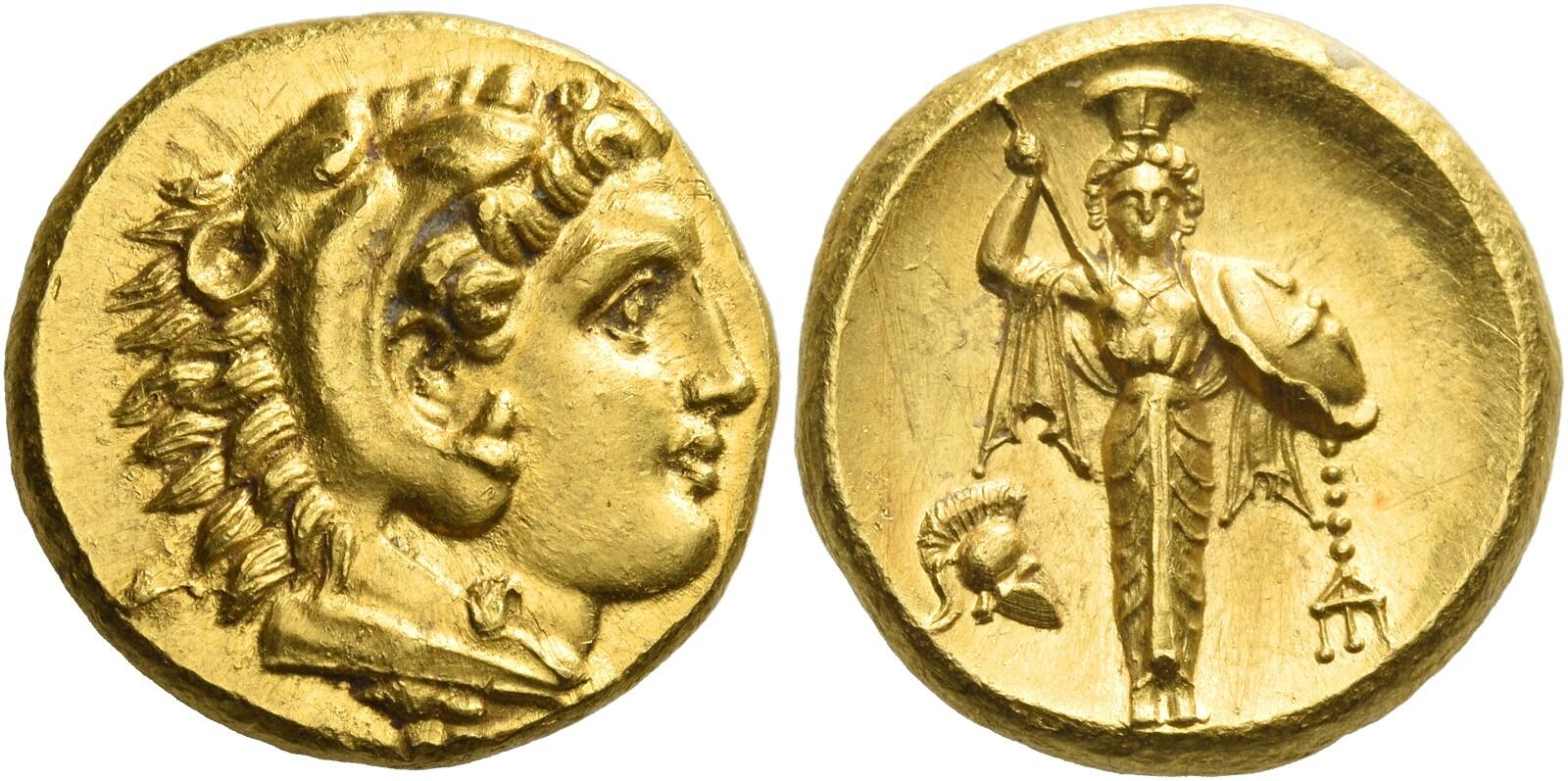Pergamum (Alexander the Great), gold, staters (335-330 BCE)
From SILVER
335 BCE - 330 BCE Gold 9,426 kg
Description
| ObverseInscription or printing placed on the obverse.: | Head of Heracles right, wearing Nemean lion skin headdress. |
| ReverseInscription or printing placed on the reverse.: | Facing Palladium, wearing calathus on head and holding lance in upraised r. hand and shield on l. arm, in lower l. field, helmet |
Mint and issuing power
| MintIdentifies the place of manufacture or issue of a numismatic object.: | Pergamum | Ancient regionAncient region.: | Mysia | Modern countryModern country: Turkey | AuthorityIdentifies the issuing power. The authority can be "pretended" when the name or the portrait of X is on the coin but he/she was not the issuing power. It can also be "uncertain" when there is no mention of X on the coin but he/she was the issuing power according to the historical sources: | Alexander III the Great (Argead king, 336-323 BC) |
Chronology
| FromIdentifies the initial date in a range assigned in a numismatic context. | 335 BCE | toIdentifies the final date in a range assigned in a numismatic context.. | 330 BCE | PeriodTime period of the numismatic object.: Classical 480-323 BC |
Physical description
| MetalThe physical material (usually metal) from which an object is made.: | Gold |
Median weightMedian of the weights of numismatic objects (in grams). in grams | 8.60 | DenominationTerm indicating the value of a numismatic object. Examples: tetradrachm, chalkous, denarius.: | stater |
StandardStandard.: | Attic |
Image

S281 Pergamum staters.jpg [1]
References
| Die study referencePublication of the study: | Callataÿ 2012b1Callataÿ 2012b | ||
| Coin series referenceReference to coin series study: | |||
Obverse dies distribution
| FrequencyFrequency of specimen in distribution. ᵖ | Number of obversesNumber of obverse dies. ᵖ (o) | % (o) | Number of coinsNumber of coins. (n) | % (n) | Die nameName(s) of the die(s). |
| 1 | 3 | 60 | 3 | 11.11 | 3, 4, 5 |
| 3 | 1 | 20 | 3 | 11.11 | 1 |
| 21 | 1 | 20 | 21 | 77.78 | 2 |
| Total | 5 of 5 | 100 | 27 of 27 | 100 |
Reverse dies distribution
no distribution is available
Quantification
| Number of obversesNumber of obverse dies. ᵖ (o) | 5 | Number of singletons (o1)The number of singleton coins. ᵖ | 3 |
| Number of reverse diesNumber of reverse dies. (r) | 7 | Number of coinsNumber of coins. (n) | 27 |
| Coins per obverse dieNumber of coins per obverse die. (n/o) | 5.4 | Coins per reverse dieNumber of coins per reverse die. (n/r) | 3.86 |
| Reverse per obverse ratioRatio of obverse dies divided by reverse dies. (r/o) | 1.4 | Percentage of singletons (o1)number of coins (n) divided by the number of singletons (o1) ᵖ | 60 % |
| Original number of dies (O) (Carter 1983 formula)The estimation of the number of coins according to Carter 1983 ᵖ | 5.48 | Coins struck if 20,000 as average productivity per dieCoins made if the average productivity for obverses (according to Carter) is 20,000. ᵖ | 109,600 |
| Original number of dies (O) (Esty 2011 formula)The estimation of the number of coins according to the singleton formula in Esty 2011 ᵖ (O) | 6.14 | Survival rate if 20,000 as average productivity per dieSurvival rate if average productivity is 20,000. ᵖ | 0.00025 |
| Coverage (o = % of O) (Esty 1984 formula)Esty 1984 - coverage (% of O) ᵖ (o = % of O) | 88.89% | Die productivity if survival rate 1/2,000Average productivity if survival rate is 1/2,000. ᵖ | 9,854.01 |
| Weight of silver (in kg) if 20,000 coins per die (O = Carter formula)Carter 1983 * Median weight * 20000 (*10 if gold or electrum) ᵖ | 9,426 kg <br /> 9,426 kg | Die productivity if survival rate 1/5,000Average productivity if survival rate is 1/5,000. ᵖ | 24,635.04 |
Remarks
Most likely one single workstation
References
- ^ Callataÿ, François de (2012), “Les statères de Pergame et les réquisitions d’Alexandre le Grand (‘Abydos’, Kios et Rhodes) : l’apport d’un nouveau trésor (‘Pergame 2004’),” Revue numismatique, 169, p. 179-196.